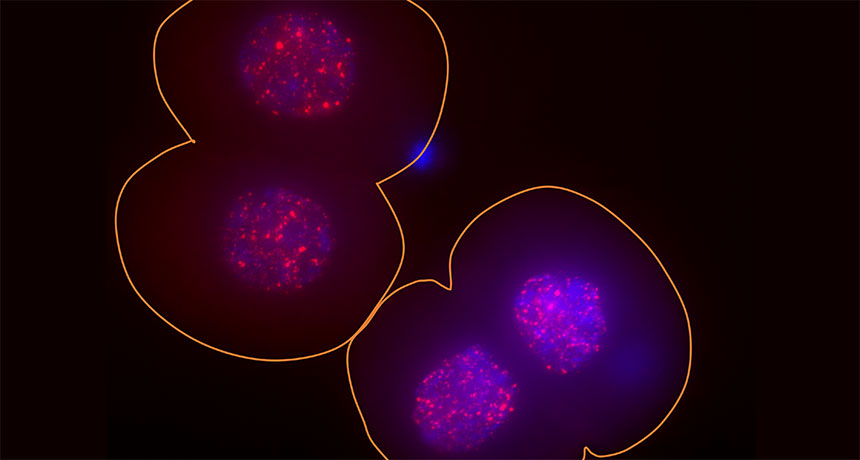This ‘junk’ gene may be important in embryo development
Mice — and maybe humans — can’t get past the two-cell stage without it

LINE-1 DANCE RNA copies of a jumping gene called LINE-1 (red) are mass produced in mouse embryos at the two-cell stage of development (shown). DNA is shown in blue and cells’ outer boundaries are drawn in orange in this microscope image.
M. Percharde et al/Cell 2018
- More than 2 years ago
A once-maligned genetic parasite may actually be essential for survival.
Mouse embryos need that genetic freeloader — a type of jumping gene, or transposon, called LINE-1 — to continue developing past the two-cell stage, researchers report in the July 7 Cell.
Many scientists “charge that these are nasty, selfish genetic elements” that jump around the genome, making mutations and wreaking havoc, says study coauthor Miguel Ramalho-Santos, a developmental and stem cell biologist at the University of California, San Francisco. But the new research suggests that the jumping gene is more helpful to development than previously thought.
Transposons certainly can hop into and break genes, and cells deploy numerous tools to prevent the jumping genes from making RNA and protein copies of themselves. But, in early development, LINE-1 is turned on nearly full blast, packing RNA into embryonic cells as well as “germline” cells, which later give rise to eggs and sperm.
Having active transposons potentially hopping around such vital cells could be dangerous. “The phrase ‘playing with fire’ comes to mind,” Ramalho-Santos says. If anything, embryos and germline cells should be among the cells most heavily guarded against transposons.
To see what the jumping gene was doing in the cells, Ramalho-Santos’ team used a short piece of RNA that could pair up with LINE-1 RNA and cause the transposon to be degraded, essentially turning off the jumping gene. (The researchers couldn’t simply remove LINE-1 from a cell; there are thousands of copies. About 17 percent of the human genetic instruction book, or genome, for instance, is made of the transposon.) Without LINE-1 RNA, embryonic stem cells stopped making more of themselves and mouse embryos failed to progress past the two-cell stage of development.
Scientists have long suspected that transposons are important for embryo development, but the idea has been hard to test, says developmental biologist Todd Macfarlan of the Eunice Kennedy Shriver National Institute of Child Health and Human Development in Bethesda, Md. The new research is one of the best demonstrations that embryos need LINE-1, he says, showing that “if you deplete LINE-1, it has consequences.”
In the study, the team found that RNA copies of the jumping gene team up with two proteins to turn off a gene called Dux. Dux helps embryos get to the two-cell stage, but having too much of it around can hinder embryos from moving beyond that stage. LINE-1 and its protein colleagues also turn on production of key pieces of protein-manufacturing factories called ribosomes, the researchers propose. Stockpiling ribosomes helps embryos churn out proteins needed for the organism to continue growing.
Macfarlan is less enthusiastic about the team’s proposal for how LINE-1 works. For instance, the two proteins that appear to collaborate with the transposon are notoriously sticky ones and may just be glomming on to LINE-1, but don’t actually aid the RNA in turning on and off specific genes, he says.
Previous work by other scientists has shown that jumping genes have shaped human evolution (SN: 5/27/17, p. 22). For instance, two proteins that help the immune system respond to new pathogens were originally transposon proteins. And some transposon remnants may have been responsible for sculpting the differences between chimpanzee and human faces.
Whether LINE-1 is as crucial for human development as it seems to be for mice is still an open question, Macfarlan says.






